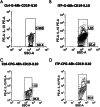CpG can induce the proliferation and differentiation of B10 cells in the peripheral blood of children with immune thrombocytopenic purpura
- PMID: 39614925
- PMCID: PMC12141354
- DOI: 10.1007/s00277-024-06105-z
CpG can induce the proliferation and differentiation of B10 cells in the peripheral blood of children with immune thrombocytopenic purpura
Abstract
Immune thrombocytopenic purpura (ITP) is a disease with a pathogenesis that remains unclear. Accordingly, this study aims to explore the role of B10 cells in ITP pathogenesis and provide a potential novel target for ITP treatment. We selected 42 children diagnosed with ITP and 29 age- and sex-matched healthy children as study objects. Peripheral blood mononuclear cells were isolated and treated with Golgplug combined with CD40L or CpG combined with CD40L, respectively. After 5 h and 48 h in vitro culture, the proportion of B10 cells in CD19 + cells was compared by flow cytometry and intracellular staining between the two groups. ITP children's prognosis was followed up to analyze the relationship between the proportion of B10 cells and the prognosis of ITP. Without CpG stimulation, the proportion of B10 cells in the peripheral blood of ITP children and healthy counterparts did not differ after 5-h in vitro culture. After 48-h in vitro culture, the proportion of B10 cells in the peripheral blood of ITP children without CpG stimulation was significantly higher than in the control group. Under CpG stimulation, the proportion of B10 cells in the peripheral blood of ITP children cultured in vitro was higher than that in the control group. In children with ITP, the proportion of peripheral blood B cells increased. Additionally, CD19 + cells were more sensitive to CpG-induced TLR9 signal stimulation in children with ITP than those in their healthy counterparts. These findings provide a research direction for ITP pathogenesis.
Keywords: B10 cell; CpG; ITP; TLR9.
© 2024. The Author(s).
Conflict of interest statement
Declarations. Ethics approval and consent to participate: Not applicable. Consent for publication: Not applicable. Competing interests: The authors declare no competing interests.
Figures









Similar articles
-
Autoimmune thrombocytopenia: flow cytometric determination of platelet-associated CD154/CD40L and CD40 on peripheral blood T and B lymphocytes.Hematology. 2007 Aug;12(4):301-7. doi: 10.1080/10245330701383957. Hematology. 2007. PMID: 17654056
-
Effect of CD40/CD40L signaling on IL-10-producing regulatory B cells in Chinese children with Henoch-Schönlein purpura nephritis.Immunol Res. 2017 Jun;65(3):592-604. doi: 10.1007/s12026-016-8877-8. Immunol Res. 2017. PMID: 27837410
-
Upregulation of CD72 expression on CD19+ CD27+ memory B cells by CD40L in primary immune thrombocytopenia.Br J Haematol. 2017 Jul;178(2):308-318. doi: 10.1111/bjh.14671. Epub 2017 Apr 17. Br J Haematol. 2017. PMID: 28419421
-
[Mechanism of cell-mediated lysis of autologous platelets in chronic idiopathic thrombocytopenic purpura].Zhonghua Yi Xue Za Zhi. 2005 Nov 16;85(43):3048-51. Zhonghua Yi Xue Za Zhi. 2005. PMID: 16324405 Chinese.
-
Direct B-cell stimulation by peripheral blood monocyte-derived dendritic cells in idiopathic thrombocytopenic purpura patients.J Clin Immunol. 2010 Nov;30(6):814-22. doi: 10.1007/s10875-010-9443-0. Epub 2010 Jul 14. J Clin Immunol. 2010. PMID: 20628793
References
-
- Hsiao CC (2000) Epstein-Barr virus associated with immune thrombocytopenic purpura in childhood: a retrospective study. J Paediatr Child Health 36:445–448 - PubMed
-
- Singh G, Bansal D, Wright NAM (2020) Immune thrombocytopenia in children: consensus and controversies. Indian J Pediatr 87:150–157 - PubMed
-
- Semple JW, Rebetz J, Maouia A, Kapur R (2020) An update on the pathophysiology of immune thrombocytopenia. Curr Opin Hematol 27:423–429 - PubMed
-
- Winiarski J (1998) Mechanisms in childhood idiopathic thrombocytopenic purpura (ITP). Acta Paediatr Suppl 424:54–56 - PubMed
MeSH terms
Substances
LinkOut - more resources
Full Text Sources

